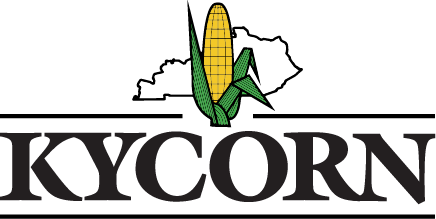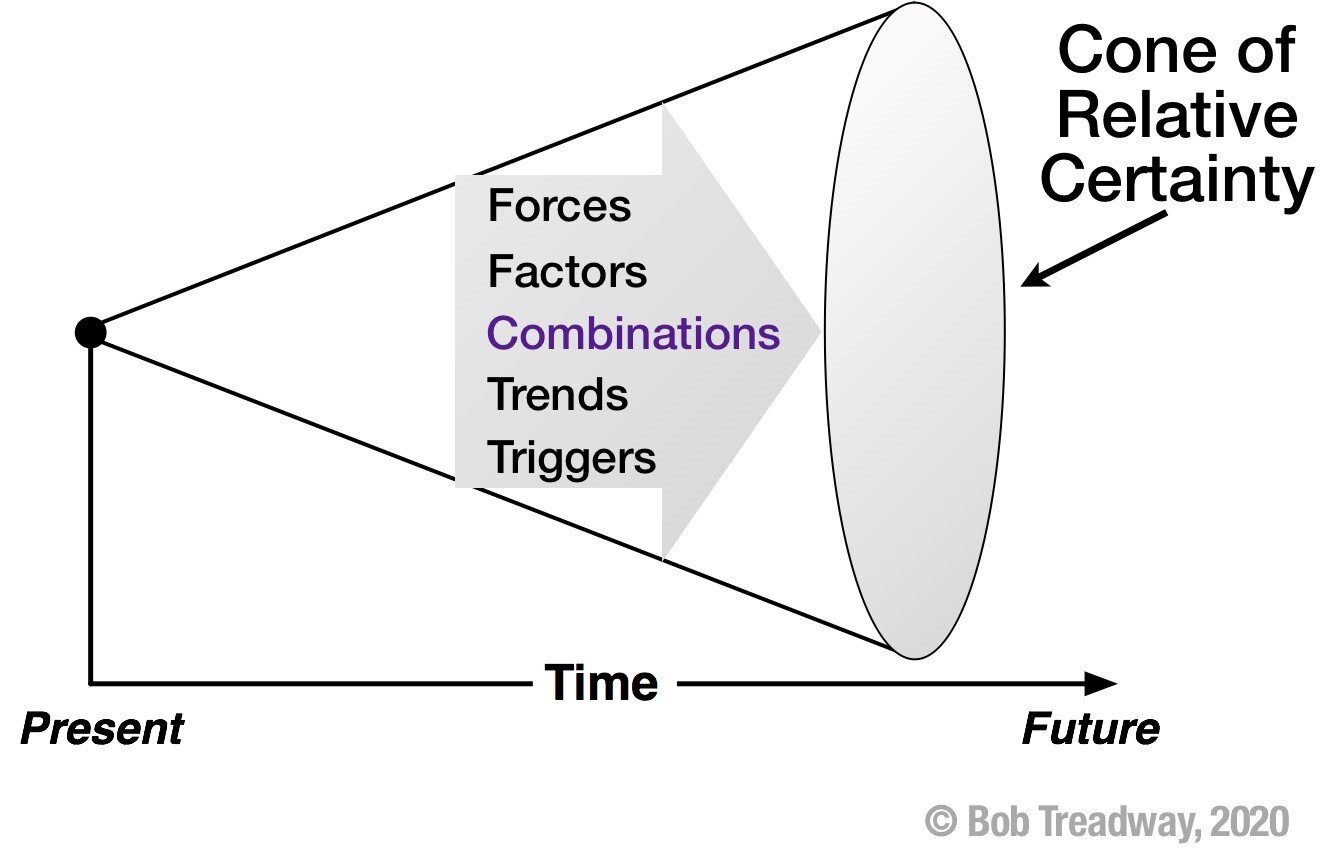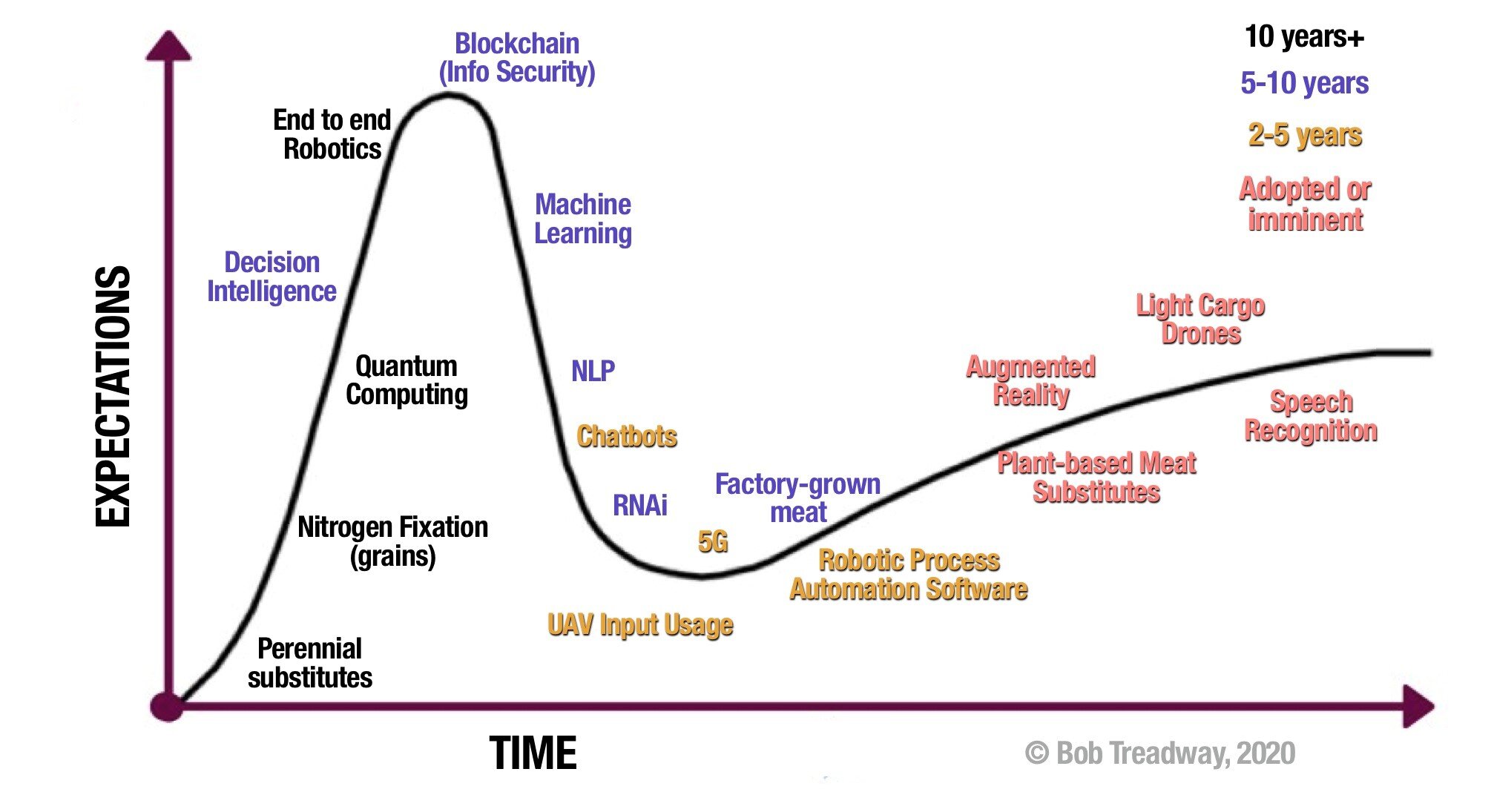KyCorn asked futurist Bob Treadway to provide the same advice to our members that he provided to the National Corn Growers Association.
Recently the National Corn Growers Association invited me to brief state association executives on the 10-20 year future for their organizations and members. Your own staff asked me for an article pointing out what Kentucky agricultural producers should be considering and working into their own strategy. Here are signals of the future and points I made based on 30 years of working with agriculture and looking at the 2030-2040 time frame. I’ve also posed some actions you could be taking now in order to be proactively ready for the future of agriculture.
How to Look Ahead
I base forecasts on a range of issues, trigger events, driving forces, trends, and stakeholder behavior. You might think that 10-20 years is too long a timeline to look at but the best organizations I work with always use long-term vision to advise and shape the decisions they make today using the approach in this illustration:
Which Operators Thrive?
Consolidation is coming for farmers and ranchers. There will be fewer but larger and more sophisticated operations in another 10 years. Expertise in business decision-making, technology choices, nimble capability to shift operations will no longer be “nice-to-haves.” They will be the bedrock intellectual assets for slightly less than half of current producers that will thrive. Another 25% of farmers carry low levels of debt, are protected by current land values, and can continue to operate as they have but will probably not see growth.
Actions? Commit to becoming smarter at the business of farming. Ask your associations to ally with institutions and learning sources to contribute to your expertise. Rethink “going your own way” and realize that alliances, combined powerful voices, and shared expertise are going to be even more necessary in the future.
Trade
Export market access through trade policy is crucial to prices and profitability in the next 20 years. Farmers and ranchers benefit by keeping markets they spent decades developing. Competitive pressures from South America and burgeoning developments that threaten biofuels and feed demand are real. Smart farmers who are my clients believe US producers can’t depend on subsidies and don’t want them. They want to compete on talent, practices, and the quality of their production. Food demand globally will go up. Asia, Africa, and the Middle East where another 2 billion consumers will be born in the next 2 decades will lead that demand. But a fair share for you and your fellow producers will depend on open, not closed markets. China is a crucial market for US output and especially for corn, DDGS, and beef – a trade category that China experts say could grow substantially in the next decade.
Actions? Raise your voice in support of a growing range of markets for your output. Belong and be active in commodity associations and alliances. Think, speak, and act globally about your part in contributing to America’s exports to feed the world what it wants to eat.
Social/Political Strategy
In 10 to 20 years US producers will want to have an even stronger bond with the American consumer and frankly, voter. The ability to simultaneously hold your own political views but also communicate and advocate with an even more diverse, informed, and opinionated consumer will be an adjustment. But the demographic and societal trends indicate more commitment and involvement with your associations, check-offs, and national commodity/product alliances. The most recent podcast from the National Corn Growers (ncga.com/stay-informed/media/podcast) features a candid conversation about the “Urban-Rural Divide” between CEO Jon Doggett and three-time Olympic gold medalist Jackie Joyner-Kersee.
Actions? Get behind your state association’s advocacy efforts. Become agnostic in reaching out to consumers and voters who won’t always share all of your opinions but stand on common ground with you in providing for their families and communities.
Biofuel Competition
“Nothing uses corn better than ethanol,” a top farm machinery executive told me in 2005. If we consider 2030 to 2040 there will still be demand for liquid fuels but there’s a threat. In that time period electric vehicles will be able to travel hundreds of miles on a charge. Batteries will be environmentally friendly. The electrical grid in America will see over half of its supply come from renewables in 2025. Gains in wind and solar will accelerate through 2040. Electric vehicles by then are not just simpler, almost maintenance-free, and substantially cheaper to operate but you’ll use the same power system for your farm machinery.
Actions? Support the RFS. Advocate for higher blends of ethanol. Emphasize the sustainability and renewable nature of ethanol. Press for investment in research and development for new uses for corn.
Other Competition
Meat substitutes and eventually non-animal meat are now and will continue to take market share. Plant protein substitutes are becoming a significant factor in fast-food and fast-casual dining in America and Europe. It’s heading to the supermarket next. What tells me it’s not going away? Ramped-up production and marketing of these substitutes by Hormel, Tyson, Smithfield, Nestle, and Perdue. While you might be skeptical of in-vitro factory-produced meat it’s about to make an appearance in the market. These are not dire threats to meat production now but we’re considering what they may mean in the market that’s 10 to 20 years ahead.
Actions? Strengthen the alliance with meat producers. Support building export markets for US producers. Look for opportunities for corn to participate in new food development.
Technology
No matter what you farm, in another 10 years technology will make up a major share of your investments, decision-making, and financial/competitive edges. Too often futurists who work in the ag sector breathlessly hype the major impacts. But when we focus a decade to two decades out we can see that developments beyond their first generation really begin to take hold and change agriculture. In the short term you’ll see the new 5G mobile system deploy allowing huge data transfers and potentially a higher level of precision, data-driven agriculture. After 2030 look for major aids to agronomic decision-making, pragmatic robotics, breakthroughs in pest resistance and drought tolerance. At the 2040 timeframe it’s realistic to expect major developments like biennial crops, perennial food crops, and even the ability of corn to fix nitrogen. I diagrammed agriculture-related developments on a “hype curve” in a recent presentation to the American Society of Farm Managers and Rural Appraisers.
Actions? Build awareness of the tools and techniques that can increase margins, enable smarter decisions, and enhance stewardship.
Bob Treadway is a globally-praised futurist, leadership educator, and strategy consultant. He’s advised clients on future operating environments for over 33 years. His clients include Gillette, Berkshire Hathaway, Motorola, the Social Security Administration, US Gypsum, the National League of Cities, the National Corn Growers Association, the Institute for Management Studies and eight North American universities where he’s been adjunct faculty and lecturer. Bob works extensively in agriculture and counts as clients the US Meat Export Federation, US Grains Council, Syngenta, Dow, the American Soybean Association, Farm Credit Services, Ag Future of America, and Canola Council of Canada.
Learn more about his work at https://trendtalk.com.




